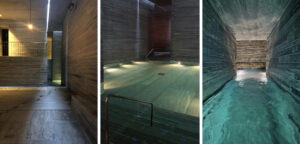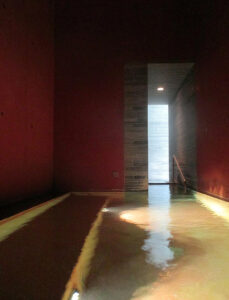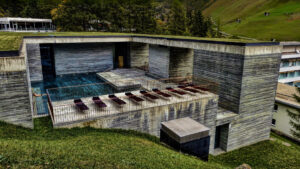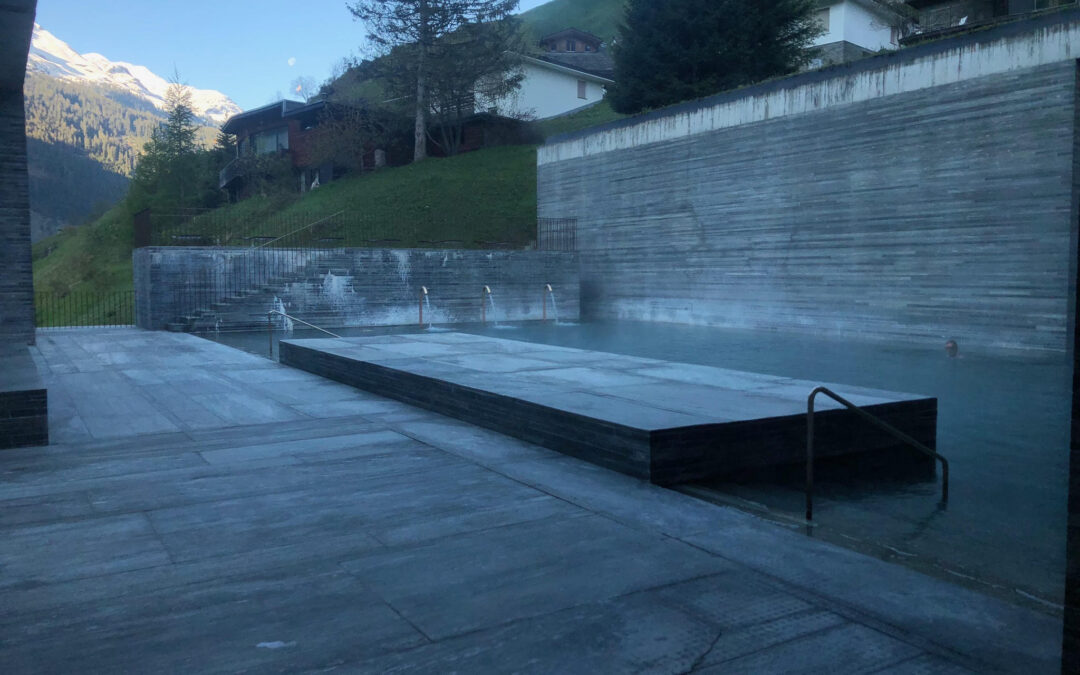Photo Credit: “Theme Vals Landscape” by Jillian Blakey is licensed under CC BY 2.0
The Thermal Baths
Peter Zumthor
Vals, Switzerland
Completed in 1996
Some buildings make you look outward. They connect you with the surrounding ecology, the place, the culture, the landscape. Others make you look inward. They prompt personal reflection, self-awareness, and contemplation. And then on rare occasions, some buildings do both.
Visiting the Thermal Baths in Vals, Switzerland, was one of these unique experiences. Nestled in a hillside in the Alps, Vals sits atop a geothermal spring that has long brought tourism to the region based on therapeutic bathing. After the financial decline of the ‘80s, Vals held an architectural competition to revive the waning tourism industry, which was awarded to Swiss architect Peter Zumthor. Zumthor’s deep-seeded “local knowledge” is abundantly evident in the building’s design, with profound understanding and respect for the landscape, culture, and above all, human experience of these elements.

Photo Credit: “Therme Vals Approach” by Jillian Blakey is licensed under CC BY 2.0
Accessing the baths requires a sort of “unlearning” process in its procession. Personally having come from life in New York City and a year of wedding planning, I was more than ready for this respite. The approach started with a long concrete tunnel, taking me below ground where the outside world felt far behind. The weight and stillness of the concrete had begun to heighten my senses, and without the distractions of extraneous stimuli, the richness of the small details began to emerge. The first thing that stood out was the sound of trickling water. Along one wall, spring water dripped from a series of recessed spigots, leaving trails of sediment and oxidation that must have been accumulating for years. The opposing wall was made of thick quartzite slabs. Each stone is slightly different in color and texture, but they are cut and stacked with such precision that it feels more like a monolithic volume.

Photo Credit: “IMG_0566” by Trevor Patt is licensed under CC BY-NC 2.0
As this volume unfolds, slivers of natural light crack through the ceiling, grazing the stone and highlighting paths of circulation. Openings in the volumes then begin to reveal glimpses of the bath’s central pool, with its iridescent water in bright contrast to the surrounding grey monolith. The procession into this new world is slow, gradual, and almost ritualistic, giving me time to acclimate, to observe the logic and rules of the space, ready to then fully immerse in the sensory wonders within.

Photo Credit: “IMG_0558” by Trevor Patt is licensed under CC BY-NC-SA 2.0
The restraint of the approach has built up a drama of anticipation, and upon entering the space I am filled with both wonder and curiosity. Every concept I learned in architecture school seems to be on full display: light and shadow, solid and void, compression and release. It feels both highly controlled in its precision and detailing, but also playful in how it encourages exploration. Around the central indoor pool there are five smaller pools, each hidden from view and tucked within volumes, and each with a different water temperature and sensory experience. The first my wife and I chose to explore was filled with flower petals and was a comfortable 33°C. Wading in, we were surprised to find a small tunnel around one corner. After ducking through the narrow passage, the ceiling vaults and the tunnel opens to a small chamber with the most amazing acoustics I’ve ever heard. Our whispers are amplified and echoing with the lapping of water. The pool has increased by 2°C to 35°C. You wouldn’t think it would be noticeable. But it is.

Photo Credit: “Therme Vals Baths” by Jillian Blakey is licensed under CC BY 2.0
Circumambulating back around the central pool, the “fire” and “ice” baths are next. At 42°C and 14°C respectively, this difference is readily apparent. The fire pool, with its glowing red walls, looks and feels like we are stepping into a volcano. The heat is all encompassing; it’s filling our lungs and permeating every muscle and fiber. It’s like a slow stretch, both mildly straining and cathartic. Once we’re fully cooked, it’s a quick sprint to the adjacent ice bath. In polar opposition, this bath’s steel-blue walls have a frosty condensation. We grit our teeth and take the plunge and the cold instantly rips through us. We can only take it for a few seconds before needing to sprint back to the fire bath, but once we recover every cell in our bodies is awake. The juxtaposition of extremes heightens the senses past the point of feeling. It’s a transcendent sense of consciousness, completely aware of the connectedness between environmental stimuli, body, and mind.

Photo Credit: “IMG_0540” by Trevor Patt is licensed under CC BY-NC-SA 2.0
Feeling recentered, we are ready to re-engage the outside world with one pool left to explore. While this last pool is primarily outdoors, a small canal branches inside, providing the option to enter through the water. This inlet makes for a smoother transition, as clouds of steam hanging above the outdoor water provide a visceral understanding of the colder mountain air. Wading through the threshold to outdoors then feels like a rebirth. We are sheltered in the enclave of the hill, but the monumentality of the landscape is all around. Massive openings in the stone frame views of the countryside, from rolling pastures where cows graze on dandelions to the snow-covered Alps in the distance. The stone slabs of the deck have retained heat from a now-absent sun, and while there are just a few of us present on this chilly spring evening, we can imagine sunbathers strewn about as they often are during summer months. This pool has all the programming of a vibrant social space, with slabs extruding in a playful topography, from benches submerged just below the water’s surface to a large platform outcropping that rises a few meters up. A dynamic social setting had been the last thing on my mind when we first came to Vals, but after going through this journey, that interest in social connectedness began to reemerge. I had had the opportunity to take a momentary break from the outside world, to feel at peace, and then to peruse sensory delights at my own pace in a process of rediscovery.

Photo Credit: “The Therme Vals / Peter Zumthor” by Mariano Mantel is licensed under CC BY 2.0
Looking back at this journey after a few years, I am that much more appreciative of such regenerative and restorative architecture. In the time since, I have specialized more as a sustainability consultant, and to me the Thermal Baths embodies what is truly needed of sustainable design. The space imbues a sense of personal connectedness between building, environment, and self. It immerses visitors in all the wonders that natural elements can bring, instilling an appreciation and desire to protect and restore such relationships. While it also addresses the more technical aspects of sustainability, such as passive heating and cooling, natural lighting, and using locally sourced materials, it is doing so much more than ‘checking the boxes’ of green building. The prescriptive and technical approach that often comes with building certifications, where building performance is typically evaluated in isolation, often leads architects to doing ‘less bad’, or at best, neutral, rather than ‘good’. It is only when such technical issues are addressed with additional humanistic and environmental considerations, how a building or space makes someone feel and the legacy of that experience, that architecture can truly become regenerative.
-by Jack Dinning

